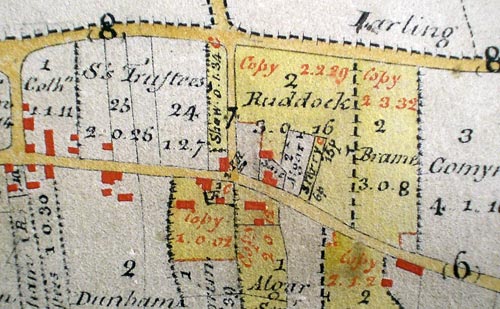
|
Bridgham
postmill |
|
Bridgham post mill was newly built c.1808 and ran a single pair of 3ft French burr stones. In 1861 it was advertised as having a large roundhouse and was running 2 pairs of stones. |
On 13th May 1843, Robert Everett, a Gentleman of East Harling, made a will to the value of £6,000.00 that was proved in 1846. The will appointed his wife Sarah, and his three sons, Robert, John & Thomas as executors. To Sarah his wife – all that windmill in Bridgham and all securities etc and the land in Orford, Suffolk. On Sarah Everett's death or remarriage all the estate was to be shared between the 3 sons. When will was proved the executors were noted as Quakers who thus gave solemn affirmation as they could not be sworn. |
Sarah Everett, widow of Robert Everett, Gentleman of East Harling wrote her will on 3rd September 1846, probably just after her husband died. She appointed her sons, Robert, John & Thomas as executors and they all gave solemn affirmation as they were Quakers, which was noted on the proving of the will Sarah Everett was recorded in the 1851 census as living in Norwich; she died on 1st February 1855 and her will was proved on 13th June 1855. She left almost everything to her sons. And also bequeath cottage, tenement with barn, stables and appertenances thereto belonging. And also the windmill and the going gears thereof as the said cottage, and hereditaments are situate and being in Bridgham, to my grandson Edwin Thomas Everett. The mill rents and profits were to go to her son Thomas and if Edwin her grandson were to die, then the mill was to be sold at the best price and divided etc. Interestingly the mill was valued at under £800.00 when a few years before the value was £6,000.00 in the will of Robert Everett. |
 |
Enclosure map 1804 - 1806 |
The enclosure map of around 1804/6 shows Ruddock's millfield. Sterry bought a few perches of land from him. His block is also in yellow to the right of Algar's. Mill house is diagonally over the road the small yellow square within a larger one. My barn was not built until around 1830 the the house is square rather than tadpole shape! It has a 'c' in the square. from the text of the enclosure award it is clear that my house was already standing, as you can see from the map, but there is no reference to, nor image of the mill. |
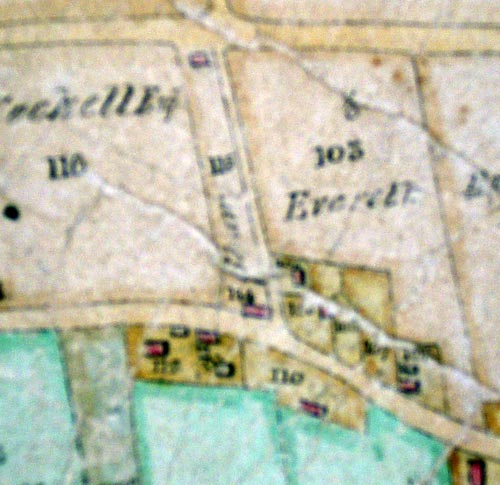 |
Tithe map 1838 |
To be Sold by Auction |
Notice to Debtors & Creditors of |
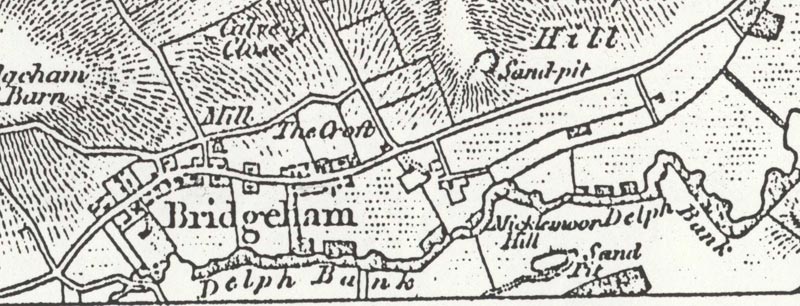 |
Map c.1835 |
John Ruddock made a will on 14th May 1836, he died on 27th May 1836 and the will was proved on 10th October 1836. The will gave John's wife Harriot all my messuages, lands, tenements and hereditaments situate in Bridgham. |
BRIDGHAM, Norfolk To be Sold by Auction by Salter & Simpson at the Swan Inn at East Harling on Tuesday 25 June 1861 at 6 o'c in the Evening A Dwelling House containing two sitting rooms etc., with Barn, Stable, Sheds, yards & Garden adjoining; and near the above a capital WINDMILL driving two pairs of stones, with large Roundhouse & nearly 3 acres of very superior Arable Land, all in the tenancy of Mr. Sayer, situated advantageously adjoining the Street & other Roads at Bridgham in Norfolk near East Harling & about two miles from the Harling Road Railway Station & affording a desirable investment & to a miller an opportunity of at once obtaining a good Country Business. Apply to E.N. Clowes & Son, Solrs., New Buckenham. Norfolk News - 8th & 22nd April 1861 |
House, Mill & Land. To be sold by Private Contract With possession at Michaelmas next A Dwelling House containing two sitting rooms etc., with Barn, Stable, Sheds, yards & Garden adjoining; and near the above a capital WINDMILL driving two pairs of stones, with large Roundhouse & nearly 3 acres of very superior Arable Land, all in the tenancy of Mr. Sayer, situated advantageously adjoining the Street & other Roads at Bridgham in Norfolk near East Harling & about two miles from the Harling Road Railway Station & affording a desirable investment & to a miller an opportunity of at once obtaining a good Country Business. Apply to E.N. Clowes & Son, Solrs., New Buckenham. Norfolk News - 20th April & Norfolk Chronicle - 27th April 1861 |
BRIDGHAM, Norfolk To be sold by Auction by Salter & Simpson at the Swan Innn at East Harling on Tuesday 25 June 1861 a 6 o'c in trhe Evening. A Capital Dwelling House containing two sitting rooms etc., with Barn, Stable, Sheds, yards & Garden adjoining; and near the above a capital WINDMILL driving two pairs of stones, with large Roundhouse & nearly 3 acres of very superior Arable Land, all in the tenancy of Mr. Sayer, situated advantageously adjoining the Street & other Roads at Bridgham in Norfolk near East Harling & about two miles from the Harling Road Railway Station & affording a desirable investment & to a miller an opportunity of at once obtaining a good Country Business. Apply to E.N. Clowes & Son, Solrs., New Buckenham. Norfolk News - 8th & 2nd June 1861 |
Windmill at Bridgham TO BE LET OR SOLD BY PRIVATE CONTRACT, a roomy Dwelling House with convenient premises, a Windmill & about Three Acres of superior Arable Land, now occupied by Mr. Sayer, situate at Bridgham, near East Harling & at the Harling Road Railway Station. Apply to Mr. J. Everett, East Harling or Messrs. E. N. Clowes & Son, New Buckenham. Norfolk News - 24th August & 14th September 1861 |
Bankrupts. From the Gazette Thomas Whitehead, Bridgham, miller. March 9 Norfolk News - 5th March 1864 |
Local Bankrupts. (From London Gazette) Tuesday March 1 Thomas Whitehead, Bridgham, Miller. Norfolk Chronicle - 5th March 1864 |
Bankrupts From The Gazette |
Local Bankrupts. (From London Gazette) Friday March 11 Thomas Whitehead, Bridgham, Journeyman Miller. Norfolk Chronicle - 19th March 1864 |
Bankrupts From The Gazette |
Situations Vacant WANTED, a Young Man about 20 years of age as MILLER at a windmill to Board & Lodge in the house. Apply to Mr. D. Davey, Bridgham, Harling. Norfolk News - 26th December 1868 |
Thomas Whitehead, journeyman miller, who was declared bankrupt in March 1864 was probably related to the miller listed as J. Whitehead in White's directory although the J. could have been simply been a misprint. |
The mill was probably demolished or moved c.1878 as George Tuck is listed as a grocer only in Kelly's directory of 1879. |
THE RUDDOCKS c.1550 - 1650 |
At least two generations of the Rudddock family were millers in Bridgham in the early nineteenth century. They held Mill Field and some of them lived in Mill House. Apart from being aware that the present Mill House structure was built around 1800, little more is known of it or its previous occupants, if any. Although this branch of the Ruddock family first appears in Bridgham records in 1780, an earlier branch was here ‘since records began’ in 1558, (and presumably before that), until 1650. For Bridgham parish registers, 1558 is when records began, so the Ruddocks may have been here for generations before this date. What happened to the family after 1650 and before 1780 is something of a mystery, and one has to ask if they are the same family at all. In support of a family connection leaping almost 250 years, there is a remarkable coincidence in that the first known Thomas Ruddock was miller of Bridgham. He owned the windmill and Mill Field which he held from the Lord of the Manor. As the post-mill was in a ruinous condition by 1900, though only ‘new built’ in 1808, it may perhaps have been a renovation of Thomas Ruddock’s mill, or a new mill on the same site - which was not unusual. It was in 1558 that Thomas Ruddock died. His will, dated 8th September 1558, gives some insight into his family life: “I give to Elizabeth Ruddock my daughter toward her bridal making 10 bushels of malt and in wheat five bushels, and I give to the same Elizabeth two ewes, 20s of money and goods, and all this to be paid to the said Elizabeth at the age of 18 years. (She married Raymond Hamblyn a year later). I give to Joan and Jan(?), my daughters, to either of them two ewes, 20s a piece to either of them and all this to be paid to them at the age of 18 years provided always that if any of them, my daughters, do depart this present world before they come to the age of 18 years then I will those that be alive shall have the part of them that be dead. I give to Thomas Ruddock my son my best feather bed with the best bolster pillow, a mattress, a pair of hemping sheets with a pillow berre, a pair of blankets, a coverlet, a cow with one bullock of two years of age, a cupboard saving I will Joan my wife shall have the occupying of the same cupboard for term of her natural life and then the said Thomas my son to have it.” There is much more of this domestic distribution to Thomas junior: "I give to the said Thomas my son two best horses, the price 20s a piece with halters, collars and harness for the same two best horses with all my tales (?) both small and great. 5 combes of barley and 5 combes of rye and 10 ewe sheep all this to be paid to the said Thomas my son at the age of 20 years. I give to Thomas my son one shodd cart with a tumbrel. They to be all to the said Thomas my son within one year of my death provided always if it shall please God to take the said Thomas my son to his mercy before he …… the age of 20 years." Of particular interest to us is the disposal of one of his main assets, the windmill: “I give to Thomas Ruddock, my son, my windmill standing in the fields of Bridgham and holding of my lord the Bishop of Ely with all things that pertaining there to ser..[unreadable]. I will Joan Ruddock my wife shall have the profits and commodities and occupation of the said windmill for the time and space of two years after my death then I will my son shall enter it with sufficient reparation and all things for the going thereof.” Thomas, was one of the chief citizens and a man of property leaving his wife “all my houses and land bound and lying in the town and folds of Bridgham.”However, there were conditions in favour of the number-one son. She received the property "...for the term of her natural life, paying the lord and finding sufficient reparations and to make no charges nor waste in nothing pertaining to the said houses and land, and if there be, then I will Thomas Ruddock my son, with two or three of the lord’s tenants with twice or thrice friendly warning, then I will for the mending thereof and if it be not mended with such friendly warning, then I will Thomas my son shall enter the said houses and land to have … use and his for ever." Two hundred and fifty years later, his likely descendants, William and John Ruddock, carried on the same tradition as pillars of the community and men of property, for as well as Mill House, John owned the White Lion (see Norfolk Pubs website) and his father, William, was the churchwarden. Returning to Thomas, we see a connection with Risley in his regard for the poor. In Ruddock’s case, though, there is an ulterior motive: “I commend my soul into the hands of my lord God, to our lady Saint Mary and all the holy company of heaven, and my body to be buried in the churchyard of our Lady in Bridgham aforesaid. I will have at the day of my burial: dirge and Mass and the poor people of Bridgham to have among them, to pray for my soul, and all share 6s 8d.” They only get the money, provided they pray for him - pray and pay! Ruddock’s windmill replaced the medieval water mills mentioned in both Domesday Book and the Bishop of Ely’s survey of 1251. The terrier reveals that he had bought many small parcels of land in Bridgham, most only of one or two acres. The locations of these strips of land are defined by who else’s land abuts them, so it is difficult to relate their whereabouts to a modern map of Bridgham. A few field names are the same as are used today, but there is no guarantee they are in the same place! Others are a complete mystery. The opening descriptions include abuttals starting at ‘burnt mill’. This is likely to be the remains of one of the two water-mills, mentioned as far back as Domesday book. They were known as West_Mill and Town_Mill. The description continues ‘the abuttals beginneth at Burnt Mill and so leadeth North towards Bridgham furres (furze?) and the Mill Field towards the West and the Town on the East.’ It is difficult to work out the starting point and the direction the terrier takes. We know that the two water-mills were half a mile apart. Could Town Mill be at the river bank south of Mill House? This may be the burnt mill and may help explain why the windmill was built direct north of it - close to the miller’s house. All this, of course, is complete conjecture. If they were the same water mills as mentioned in Domesday book, they were nearly 500 years old at least in 1558! 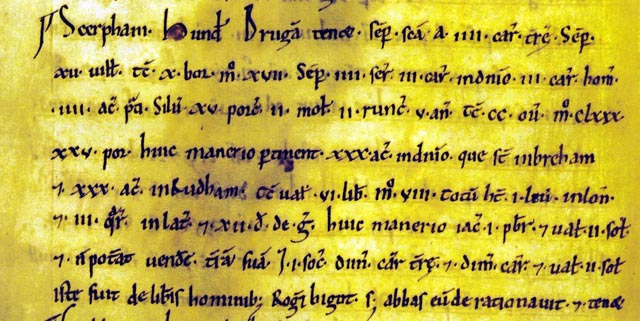 Extract from Domesday relating to Bridgham and the mills |
Thomas Ruddock is mentioned in the terrier as his land abuts that of Sir Thomas Lovell’s: ‘3 roods lying between the land of the parson of Bridgham to the West and the land of Thomas Ruddock to the East, whose south head lieth upon Micklemeere way and the north head upon Mancrofts. Again, its location is not specific, but there were fields named Mancroft and Micklemere in the Tithe Award of 1838, but they were not near Mill Field. Thomas Ruddock junior (who was born around 1539) married Alys and they had four known children: Elizabeth, Anne (who died within a year), George, and another Ann. There was also a Henry Ruddock of a similar age to them, but whether he is a brother to them is not known. Henry and his wife Ann (née Leader) produced a succession of children from 1583 until 1608 – 25 years(!): Thomas, Joan, (the names of Thomas junior’s parents, so Henry is probably a close relative), Ann, Thomas again (the first one died in infancy), and George or Henry (the name is difficult to read). Around this time, a neighbouring priest wrote that the people of Bridgham were: ‘wholly bent to the toil of manual affairs and the tilth of the ground’. Life was a hard grind, a term a miller would appreciate. There are several more generations of Ruddocks in Bridgham, but establishing a family tree is difficult. The same names recur, but most of those who were baptised in Bridgham were not married or buried here and vice versa. The family disappears from Bridgham records in 1650 (following three burials), but that does not mean there were not any Ruddocks in the village, but simply that they were not baptised, married or buried here. Although there is a 130-year gap before the Ruddocks next appear in Bridgham records, can it be coincidence that the new family is also one of millers, perhaps working on the site of their possible ancestors’ mill?
David O'Neale - 20th January 2008 |
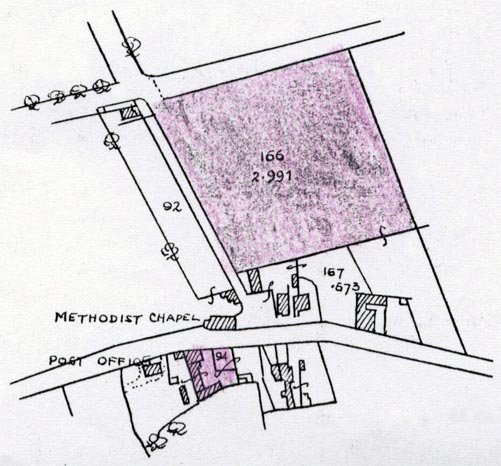 |
1905 map showing Mill House and field where mill stood |
 |
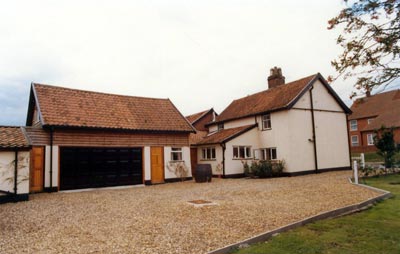 |
Mill House c.1982 |
Estate agent photo 1987 |
Greetings from Australia 1. John RUDDOCK sp: Mary HUNT 2. Mercy RUDDOCK (born c.1780 Bridgham, Norfolk d.1815) 2. John RUDDOCK (born12 Oct 1785 Bridgham, Norfolk) 2. Rebecca RUDDOCK (born 24 Jul 1788 Bridgham, Norfolk) 2. Ragau RUDDOCK (born c.1792 Bridgham, Norfolk) Robert Sterry, New South Wales, Australia - 10th February 2009 |
 |
O.S. Map 1905 Courtesy of NLS map images Mill site (top) and mill house marked in red |
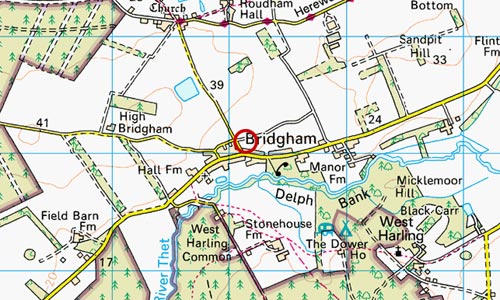 |
O.S. Map 2005 Image reproduced under licence from Ordnance Survey |
8th September 1558: Thomas Ruddock snr, miller made a will and died later the same year
Kelly's 1854: Batson Porter, corn miller White's 1854: Potter Batson, miller 1855: Sarah Everett, mill owner died leaving the mill to her grandson Edwin Thomas Everett 1858-63: Thomas Sayer, miller - previously at Shropham Mill Lane smockmill
April 1861: Mill advertised for sale by auction September 1861: Mill advertised for sale by private contract September 1861: Mill advertised for sale or let White's 1864: J. Whitehead, corn miller March 1864: Thomas Whitehead, journeyman miller, bankrupt 1865: John Brame, miller 1868: David Davy, miller 1871: Robert Pinner, master miller aged 21 1872: George Pitcher, miller 1874: George Tuck, miller 1875: David Davy, miller 1878: George Tuck, miller c.1878: Mill demolished 28th January 1988 - : David O' Neale & Hilary Farmbrough, Mill House |
If you have any memories, anecdotes or photos please let us know and we may be able to use them to update the site. By all means telephone 07836 675369 or
|
| Nat Grid Ref TL96158610 |
Copyright © Jonathan Neville 2006 |